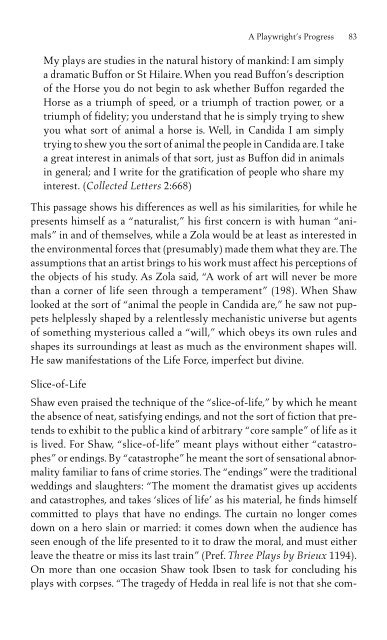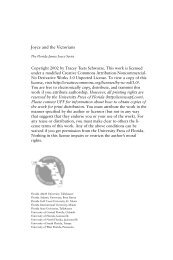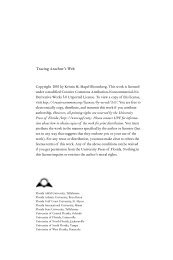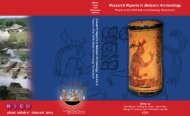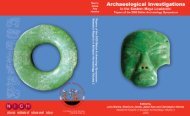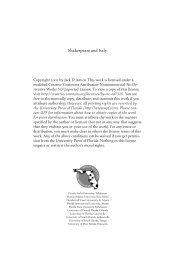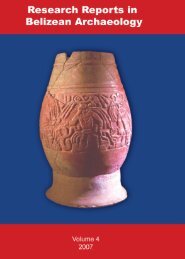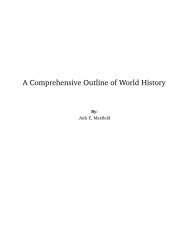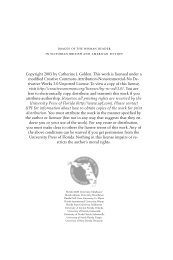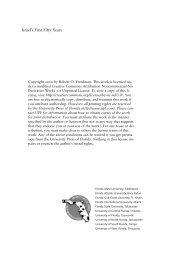Bernard Shaw's Remarkable Religion: A Faith That Fits the Facts
Bernard Shaw's Remarkable Religion: A Faith That Fits the Facts
Bernard Shaw's Remarkable Religion: A Faith That Fits the Facts
You also want an ePaper? Increase the reach of your titles
YUMPU automatically turns print PDFs into web optimized ePapers that Google loves.
A Playwright’s Progress 83<br />
My plays are studies in <strong>the</strong> natural history of mankind: I am simply<br />
a dramatic Buffon or St Hilaire. When you read Buffon’s description<br />
of <strong>the</strong> Horse you do not begin to ask whe<strong>the</strong>r Buffon regarded <strong>the</strong><br />
Horse as a triumph of speed, or a triumph of traction power, or a<br />
triumph of fidelity; you understand that he is simply trying to shew<br />
you what sort of animal a horse is. Well, in Candida I am simply<br />
trying to shew you <strong>the</strong> sort of animal <strong>the</strong> people in Candida are. I take<br />
a great interest in animals of that sort, just as Buffon did in animals<br />
in general; and I write for <strong>the</strong> gratification of people who share my<br />
interest. (Collected Letters 2:668)<br />
This passage shows his differences as well as his similarities, for while he<br />
presents himself as a “naturalist,” his first concern is with human “animals”<br />
in and of <strong>the</strong>mselves, while a Zola would be at least as interested in<br />
<strong>the</strong> environmental forces that (presumably) made <strong>the</strong>m what <strong>the</strong>y are. The<br />
assumptions that an artist brings to his work must affect his perceptions of<br />
<strong>the</strong> objects of his study. As Zola said, “A work of art will never be more<br />
than a corner of life seen through a temperament” (198). When Shaw<br />
looked at <strong>the</strong> sort of “animal <strong>the</strong> people in Candida are,” he saw not puppets<br />
helplessly shaped by a relentlessly mechanistic universe but agents<br />
of something mysterious called a “will,” which obeys its own rules and<br />
shapes its surroundings at least as much as <strong>the</strong> environment shapes will.<br />
He saw manifestations of <strong>the</strong> Life Force, imperfect but divine.<br />
Slice-of-Life<br />
Shaw even praised <strong>the</strong> technique of <strong>the</strong> “slice-of-life,” by which he meant<br />
<strong>the</strong> absence of neat, satisfying endings, and not <strong>the</strong> sort of fiction that pretends<br />
to exhibit to <strong>the</strong> public a kind of arbitrary “core sample” of life as it<br />
is lived. For Shaw, “slice-of-life” meant plays without ei<strong>the</strong>r “catastrophes”<br />
or endings. By “catastrophe” he meant <strong>the</strong> sort of sensational abnormality<br />
familiar to fans of crime stories. The “endings” were <strong>the</strong> traditional<br />
weddings and slaughters: “The moment <strong>the</strong> dramatist gives up accidents<br />
and catastrophes, and takes ‘slices of life’ as his material, he finds himself<br />
committed to plays that have no endings. The curtain no longer comes<br />
down on a hero slain or married: it comes down when <strong>the</strong> audience has<br />
seen enough of <strong>the</strong> life presented to it to draw <strong>the</strong> moral, and must ei<strong>the</strong>r<br />
leave <strong>the</strong> <strong>the</strong>atre or miss its last train” (Pref. Three Plays by Brieux 1194).<br />
On more than one occasion Shaw took Ibsen to task for concluding his<br />
plays with corpses. “The tragedy of Hedda in real life is not that she com-


